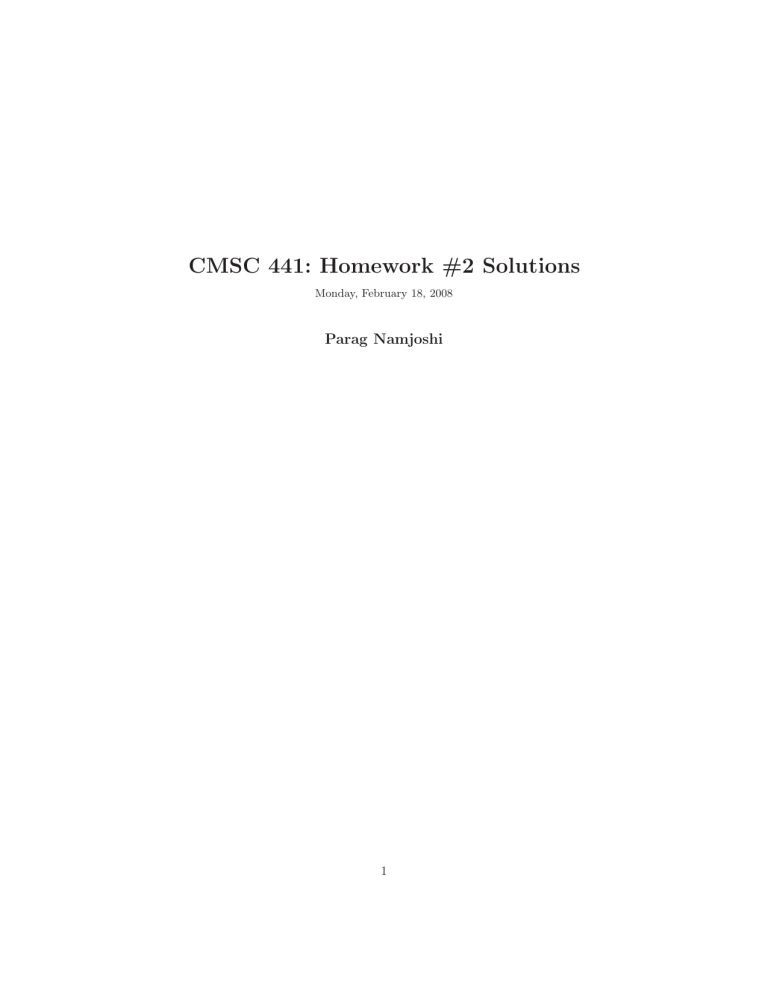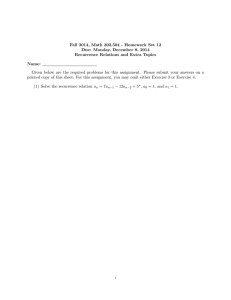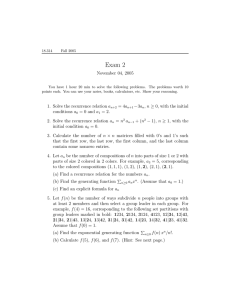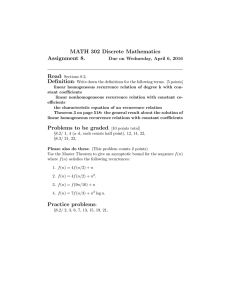CMSC 441: Homework #2 Solutions
advertisement

CMSC 441: Homework #2 Solutions Monday, February 18, 2008 Parag Namjoshi 1 Exercise 4.1–1 Show that the solution of T (n) = T (⌈n/2⌉) + 1 is O(lg n) Solution: We guess that the solution is T (n) = O(lg n). We must prove that T (n) ≤ c lg n for appropriate c > 0. We start by assuming that this bound holds for ⌈n/2⌉, that is that T (⌈n/2⌉) ≤ c lg(⌈n/2⌉). Substituting into the recurrence yields T (n) ≤ c lg(⌈n/2⌉) + 1 ≤ c lg(n/2) + 1 = c lg n − c lg2 + 1 = c lg n − c + 1 = c lg n if c ≥ 1 the last step holds as long as c ≥ 1. For the base case, it suffices∗ to show that T (2) ≤ c lg 2 for some c ≥ 1. T (2) = T (1) + 1 or T (2) = 2 assuming T (1) = 1. Thus T (2) ≤ c lg 2 if c ≥ 2. Exercise 4.1–2 We saw that the solution of T (n) = 2T (⌊n/2⌋) + n is O(n lg n). Show that the solution of this recurrence is also Ω(n lg n). Conclude that the solution is Θ(n lg n). Solution: We guess that the solution is T (n) = Ω(n lg n). We must prove that T (n) ≥ cn lg n for appropriate c > 0. We start by assuming that this bound holds for ⌊n/2⌋, that is that T (⌊n/2⌋) ≥ c⌊n/2⌋lg(⌊n/2⌋). Substituting into the recurrence yields T (n) ≥ 2c⌊n/2⌋ lg(⌊n/2⌋) + n ≥ cn lg(n/2) + n = cn lg n − cn lg2 + n = c lg n − cn + n = cn lg n if c ≤ 1 the last step holds as long as c ≥ 1. For the base case, we must show that T (2) ≤ c lg 2 and T (3) ≤ c lg 3† for some c ≥ 1. T (2) = 2T (1) + 2 or T (2) = 4 assuming T (1) = 1. Similarly, T (3) = 2T (1) + 3 or T (2) = 5.Thus T (2) ≥ c lg 2 and T (3) ≥ c lg 3 if c ≤ 1. Exercise 4.1–6 √ Solve the recurrence T (n) = 2T ( n) + 1 by making a change of variables. Your solution should be asymptotically tight. Do not worry about whether values are integral. ∗ In † In this exercise, it is not necessary to show T (3) ≤ c lg 3. Why ? this exercise, it is necessary to show T (3) ≤ c lg 3 as well. Why ? Exercise 4.1–6 continued on next page. . . Page 2 of 3 Solution: Let m = lg n, thus, T (2m ) = 2T (2m/2 ) + 1, We now rename S(m) = T (2m ) to produce new recurrence S(m) = 2S(m/2) + 1. From the arguments on similar lines to first exercise, S(m) = Θ(m). Changing back to T (n) and re– substituting m = lg n, T (n) = Θ(lg n). Page 3 of 3




